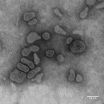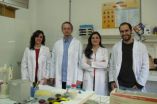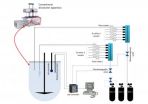(Press-News.org) CORVALLIS, Ore. – Researchers at Oregon State University have discovered novel proteins in, or on the surface of the bacteria that causes gonorrhea, which offer a promising new avenue of attack against a venereal disease that is showing increased resistance to the antibiotics used to treat it.
Only a single, third-generation cephalosporin antibiotic still shows good efficacy against gonorrhea, creating a race against time to find some alternative way to treat this disease that can have serious health effects. It's the second most commonly reported infectious disease in the United States.
Investigations based on these proteins might lead to new ways to combat the disease, including a vaccine, new types of drugs to block the growth of the bacteria, or even restoring the efficacy of some older antibiotics that have lost their usefulness, said Aleksandra Sikora, an assistant professor in the OSU College of Pharmacy.
"This could be a milestone in finding new ways to treat a global problem," Sikora said. "It appears that one or more of these proteins, either within the bacterial cell envelope or on its surface, are essential to its growth and survival. Now we have a new target to aim at."
World health officials have raised alarms that the growing resistance of gonorrhea to antibiotics could cause it to become untreatable. There are more than 60 million cases of this venereal disease treated around the world every year – and 300,000 just in the U.S. – in people who experience clear symptoms. But some of the worst damage is done among millions of other cases that are very mild or asymptomatic.
Such symptomless infections, most common in women, can cause pelvic inflammatory disease, ectopic pregnancy and infertility, as well as increase the transmission of the HIV virus. Gonorrhea can also affect joints and heart valves, and cause blindness in infants infected during birth.
The new findings were just published in Molecular and Cellular Proteomics, by researchers from OSU and the University of Washington. The research has been supported by OSU and the Medical Research Foundation of Oregon.
Using the evolving science of proteomics - which is the large-scale, high-throughput study of proteins and their functions - researchers identified a plethora of proteins that reside in a space in the gonorrhea bacteria, an "envelope" and its small outpouchings, or membrane vesicles.
This cell envelope shields the interior of gonorrhea from the environment and is essential for survival of the microbes, as well as their ability to cause disease. The proteins localized there help acquire nutrients, provide a permeability barrier, suppress the immune response and keep the bacteria fit.
Other proteins on the bacteria surface also help it attach to the host. The membrane vesicles are spherical structures that contain proteins and DNA, and are involved in antibiotic resistance, microbe communication and delivery of factors important for infection.
Any or all of these proteins may now offer a way to attack the survival and spread of the gonorrhea bacteria, Sikora said. None of them have yet been used for that purpose.
"Some past approaches to create a gonorrhea vaccine failed because they were focused on proteins essential to infection, which were quite unstable," she said. "Because they were changing so constantly they were unsuitable for a vaccine. The proteins we've now identified offer a much more stable and vulnerable target."
Researchers have already quantified their abundance of these cell envelope proteins and are learning their basic function, and in continued studies will screen compounds for activity against some of them.
"With this information, the chance to create either a vaccine or new drug treatments is very promising," Sikora said.
The gonorrhea bacteria, Neisseria gonorrhoeae, is a pathogen specific to humans and no other animals. It dates to antiquity and it's uncertain when it first developed. Many epidemics have been reported in world history.
INFORMATION:
Editor's Note: An electron micrograph image to illustrate this story is available online: http://bit.ly/1f0Dlfg
Proteins discovered in gonorrhea may offer new approach to treatment
2014-03-31
ELSE PRESS RELEASES FROM THIS DATE:
Where to get Viagra news? (Really, this isn't spam)
2014-03-31
RIVERSIDE, Calif. — Do you want information on Viagra or ibuprofen? Check out general social networks such as Twitter and Pinterest. Interested in sleep disorders or depression? You're better off going to specialized health social networks such as WebMD or drugs.com.
That is one of the findings of a just published paper, "Pharmaceutical Drugs Chatter on Online Social Networks," based on an analysis of more than 1 million drug-related posts, by a team of researchers at the University of California, Riverside's Bourns College of Engineering and Zhejiang University in China.
The ...
Biolimus still comparable to everolimus in year 2 of stent match-up
2014-03-31
WASHINGTON (March 31, 2014) — A new stent covered with biodegradable coating continues to show statistical equivalence to Japan's market leader in cumulative second-year data and subgroup analyses, according to research from the NEXT trial presented at the American College of Cardiology's 63rd Annual Scientific Session. NEXT is the largest head-to-head randomized study of these two stents – the novel biolimus-releasing model with the degradable coating (BES) and the everolimus-releasing standard with a durable polymer (EES).
Polymer coatings contain the drugs in drug-eluting ...
Tested a drug that strengthens the analgesic effect of opioids without increasing constipation
2014-03-31
Scientists from the University of Granada have taken part, alongside the Esteve laboratory, in the development of a new drug that multiplies the analgesic effect of opioids (drugs for treating intense pain), without increasing constipation, one of the most common side-effects of these drugs, among which is morphine.
This important scientific breakthrough has been published in The Journal of Pharmacology and Experimental Therapeutics, and has been chosen as its outstanding article in the month of January. So far, the University of Granada researchers have published the ...
Researchers develop device that simulates gastro-intestinal tract
2014-03-31
A breakthrough in drug testing developed by a University of Huddersfield lecturer could lead to cheaper, more effective medicines. Dr Hamid Merchant is a member of the team that has created a device which accurately simulates the gastro-intestinal tract and how it absorbs medication. This means that the cost of clinical trials could be greatly reduced, with savings passed on to customers.
Dr Merchant has joined the University as a Senior Lecturer in Pharmaceutics. Previously a postdoctoral fellow at University College London (UCL), he has extensive research experience, ...
Certain genetic variants may identify patients at higher risk of bladder cancer recurrence
2014-03-31
While patients diagnosed with bladder cancer usually face a favorable prognosis, many experience recurrence after treatment. Because frequent, painful screenings are needed to identify recurrences, the ablility to identify patients at high risk of recurrent cancer could help to improve quality of life for all bladder cancer patients.
A new study published in BJU International, "Genetic polymorphisms modify bladder cancer recurrence and survival in a U.S. population-based prognostic study," suggests that certain inherited DNA sequences may affect a bladder cancer patient's ...
Heparin more effective than bivalirudin in patients during emergency heart procedure
2014-03-31
WASHINGTON (March 31, 2014) — In a comparison of two blood-thinning medications, heparin was associated with significantly fewer major cardiovascular events at 28 days than bivalirudin in patients receiving primary percutaneous coronary intervention after a heart attack, according to research presented at the American College of Cardiology's 63rd Annual Scientific Session.
The single-center, open label trial enrolled 1,829 patients with suspected heart attack who received a coronary angiography, an imaging test to see how blood flows through the heart. Patients were randomized ...
Anti-anxiety drugs and sleeping pills linked to risk of death
2014-03-31
Anti-anxiety drugs and sleeping pills have been linked to an increased risk of death, according to new research from the University of Warwick.
The large study, published in BMJ, shows that several anxiolytic (anti-anxiety) drugs or hypnotic drugs (sleeping pills) are associated with a doubling in the risk of mortality.
Although these findings are based on routine data and need to be interpreted cautiously, the researchers recommended that a greater understanding of their impact is essential.
Professor Scott Weich, Professor of
Psychiatry at the University of ...
Drug-eluting stents demonstrate better outcomes after 1 year than bare metal stents
2014-03-31
WASHINGTON (March 31, 2014) — Use of drug-eluting stents is associated with a lower risk of major cardiovascular events at one year compared to bare metal stents when followed by an individualized course of blood-thinning medication among patients previously thought to be uncertain candidates for drug-eluting stents due to their heightened risk of bleeding or blood clots, according to research presented at the American College of Cardiology's 63rd Annual Scientific Session.
Positive study findings for patients receiving a shorter than currently recommended course of ...
Never say never in the nano-world
2014-03-31
This news release is available in German.
Objects with sizes in the nanometer range, such as the molecular building blocks of living cells or nanotechnological devices, are continuously exposed to random collisions with surrounding molecules. In such fluctuating environments the fundamental laws of thermodynamics that govern our macroscopic world need to be rewritten. An international team of researchers from Barcelona, Zurich and Vienna found that a nanoparticle trapped with laser light temporarily violates the famous second law of thermodynamics, something that ...
New human trial shows stem cells are effective for failing hearts
2014-03-31
WASHINGTON (March 31, 2014) — Patients with severe ischemic heart disease and heart failure can benefit from a new treatment in which stem cells found in bone marrow are injected directly into the heart muscle, according to research presented at the American College of Cardiology's 63rd Annual Scientific Session.
"Our results show that this stem cell treatment is safe and it improves heart function when compared to placebo," said Anders Bruun Mathiasen, M.D., research fellow in the Cardiac Catherization Lab at Rigshospitalet University Hospital Copenhagen, and lead investigator ...



